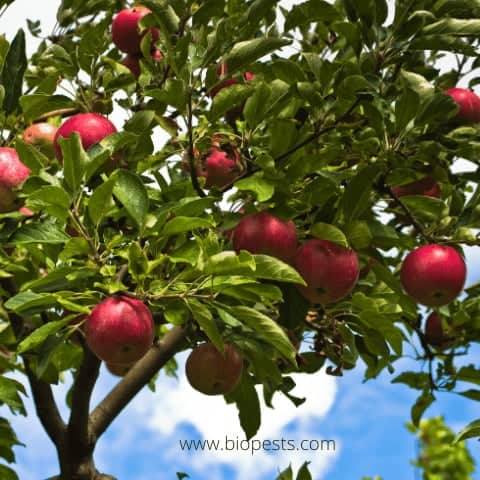Growing your own fruit and vegetables brings a lot of satisfaction but when you discover that your fruit, for which you have worked so hard, is attacked by worms or other parasites … well it’s hard to contain the anger.
Luckily there are some measures that you can take to prevent pest attacks on your beloved apple trees.
There is no single nor proven method, rather a series of preventive measures that together can drastically reduce the chances of infestation.
Apples are one of the most loved fruits in the world, and it is not surprising that apple trees are very popular among landowners. Unfortunately, many parasites also come with apples.
How To Prevent Pests From Attacking Your Apple Tree
According to the season, these are steps to take to prevent and reduce pest attacks on your apple tree:
| SEASON | ACTION | DETAILS |
| FALL October | Paint the tree | Protect the bark from sunburn, rodents and pests by painting with a diluted solution 50:50 of water and white latex. |
| WINTER from November to February | Prune Your Tree | Remove all broken, crossed, diseased, and dead branches. Cut off overgrown branches or any sign of new growth. |
| Spray with dormant oil* | Dormant sprays damage the parasite’s outer cells and suffocate them to death. | |
| Clean up the area | Remove anything that could be a carrier of pests, fungi, and disease: that means dead leaves, rotten fruit, and dead branches. | |
| SPRING March and April | Spray with a fungicide mixed with some horticultural oil | spray and completely cover the tree every 10 days- 2 weeks especially in case of rain |
| SUMMER May to September | Spray with Kaolin Clay | Kaolin clay is a powerful insect repellent. It covers the tree and fruit with a thin film of clay, which discourages insects from feeding and laying eggs on the plant. |
*If you want to know more about dormant oil, check this article here.
The above are just general rules to follow for any apple tree.
Unfortunately, each season brings its own pest, with its characteristics. It is very important to identify them and find a targeted solution for each of them.
Let’s see which are the most common pests that attack your apple trees.
How To Prevent And Control Common Apple Trees Pests:
The following is a list of the most common pests that feed on apple trees and how to prevent them:
Aphids:
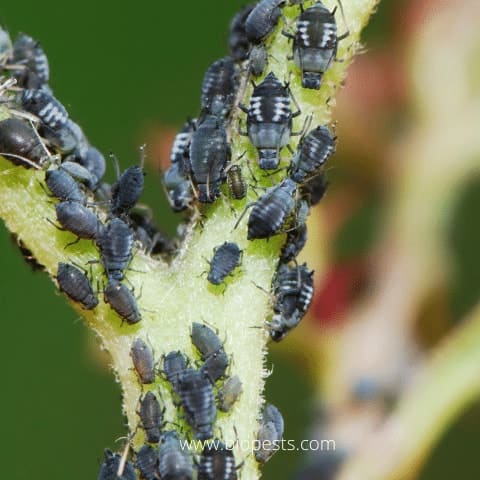
These are small (less than 1/4 of inch), soft-bodied insects that feed by sucking the nutrient-rich liquids out of plants. They love to feast on young leaves and flowers. Their color can range from green, brown, yellow and black. They are quite small but it’s relatively easy to spot them because they are usually clustered at the ends of the plants, sucking from the buds.
Prevention: Spraying the tree with horticultural oil (dormant oil) during winter will prevent the aphid’s eggs from hatching. The oil works by suffocating the eggs before they become a problem.
Did you know that it is possible to make your own organic horticultural oil at home? This is a great alternative to conventional pesticides that could be harmful to children, pets, and other animals.
The recipe for your own horticultural organic oil is:
- In one cup of soybean oil mix 1 tablespoon of Castile soap.
- For every cup of water, mix 2 tablespoons of your oil solution.
- Pour into a spray bottle and spray directly on the plant.
Control: There are many measures to defeat aphids organically. You can either kill them with soapy water spray or garlic & hot pepper spray. Here you can learn how to prepare your homemade pesticide.
Apple Maggot Fly:
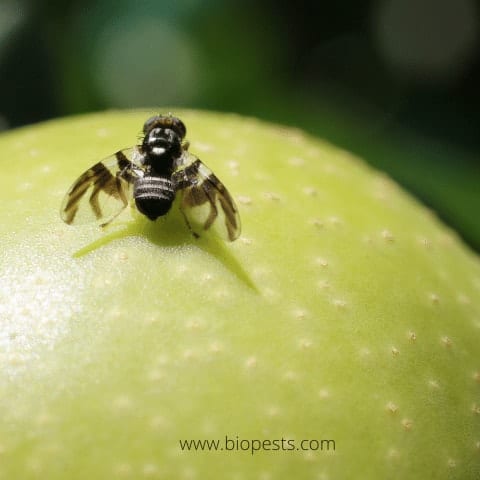
This insect is slightly smaller than a common fly. The larvae (1/4 inch long) are white, tapering worms that tunnel through the fruit pulp. Sometimes they are called rail worms. These flies are one of the most feared apple pests as they do extensive damage.
Apple maggots overwinter as pupae in the soil. They begin to emerge from the ground in early summer.
They lay eggs under the peel of apples.
When the eggs hatch, the larvae feed on the apple pulp for about a month. The cycle repeats itself when the apples fall to the ground and the now pupal larvae overwinter underground, emerging as adults the following summer.
Prevention: Cleaning up under the trees, removing all the rotten apples and leaves will help in preventing the pupae from emerging in the summer. Spray the tree with kaolin clay at the end of the spring and during the summer. This will discourage the insects from laying their eggs. Another form of prevention is the use of red sphere traps. These sticky plastic spheres resemble the shape and color of apples, attracting the apple maggot fly that will stick to it.
Control: You can apply some beneficial nematodes to the soil surrounding your tree during fall and winter. The nematodes will attack and kill the pupae. If you want to read more about these amazing microscopic worms and how they work, read this article.
Plum Curculio:
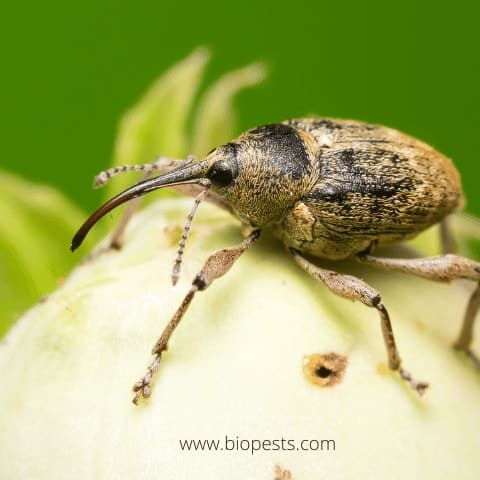
Plum Curculio is a parasite found throughout North America. It is a pest that, in addition to apple trees, attacks plum, peach, pear, and cherry trees. At the beginning of the spring season, you can spot the first sign of damages that will continue until the end of summer.
This 1/4 inch insect makes a crescent-shaped hole in fruit skins and lays its eggs inside. The larvae tunnel through the apples, causing the fruit to drop in early summer. Just like apple maggot flies, these insects overwinter under the debris in the vicinity of the fruit tree. As the adults emerge in spring, they begin to feed on flower buds and young fruit. The female specimens mate and lay their eggs in the fruit.
Prevention: Cleaning up under the trees, removing all the rotten apples and leaves will help to reduce the population of curculio since it disturbs its life cycle.
Control: It is possible to control the curculio population by spraying organic pesticides at petal fall. You can use canola oil-based pesticides. Vegetable oil works by suffocating the eggs and larvae of multiple insects. In addition to garlic and hot pepper pesticides mentioned above, it is also possible to create pesticides based on cinnamon oil. You can create a powerful pesticide at home by mixing one tablespoon of cinnamon oil, one cup of canola oil, and one liter of water. Pour into a spray can and spray directly on the tree. Caution: initially purge only a small portion of the tree to check the reaction of the plant to the cinnamon. In fact, too much cinnamon oil could potentially damage the leaves of the tree. If you see that the leaves do not change in appearance, spray the entire tree.
Codling Moth
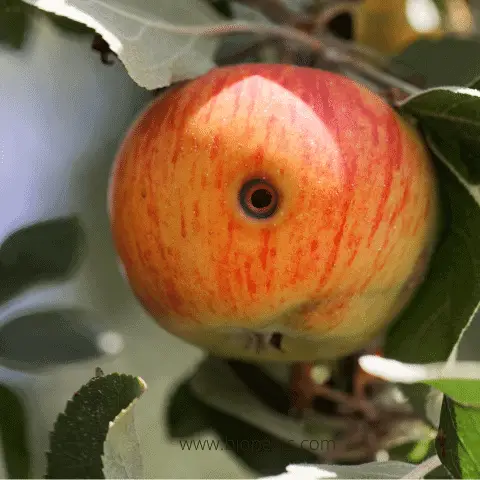
The Codling moth is a serious pest that atacks apples, pears, and English walnuts trees.
If you happen to find a tiny caterpillar while eating an apple or a pear, chances are you’ve come across the codling moth larvae. The larvae have the appearance of a small white or light pink worm with a dark brown head. At the beginning of spring, Codling moths lay their eggs on the very young developing fruit right after the petals fall. After a few days, the eggs hatch, and the young larvae feed on the fruit, destroying it in the process.
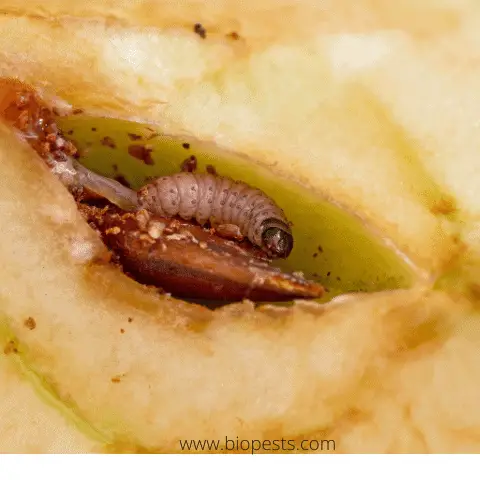
Prevention: Pruning trees to a height where the canopy is easy to reach can help in the management of this pest. Removing infested fruit from the tree and promptly picking up dropped fruit from the ground is most critical because they can have larvae in them.
Spray with Kaolin clay at the beginning of the spring to prevent the insect from laying its eggs.
Control: A good pest control can be achieved by enclosing young fruit in bags right on the tree to protect them from the codling moth. However, bagging the fruit can be quite time-consuming therefore it is most manageable in smaller gardens.
Bagging should be done four to six weeks after the bloom season when the fruit is already 1/2 to 1 inch in diameter.
Bud Moth
The damage of the bud moth is mainly to the leaves and the buds of the plant. Bud moths are greyish in color and are about 0.4 inches long with a broad white band on each front wing. The larvae are chocolate brown with black heads and are about up to 1 inch long.
The larvae spend the winter in a cocoon stage on the bark. In early spring, as the leaves sprout, they become active and begin feeding on the buds as well as on the leaves.
Prevention: Adult specimens lay eggs on shoots and new foliage as trees begin to sprout in spring. The caterpillars initially feed on the leaves, then channel themselves into the stems. Treatment should be aimed at worms while they are on the leaves. It is important to act early and avoid the larvae from building their nest since insecticides will not reach them once their nest is webbed.
Flatheaded Apple Tree Borer
Another fearsome enemy of your apple tree is the the Flatheaded Apple Tree borer. An infestation could potentially lead to the death of a tree!
Adult Flathead borers are 1/2 inch long wood-boring pests.
Both types of borers lay eggs in sun-exposed cracks in the bark. From mid to late summer, the eggs hatch, and the larvae immediately begin to penetrate the plant. Larvae are pale yellow and spend the winter under the bark. They complete their development the following spring, and cut a chamber into the sapwood and pupate.
Usually these insects prefer trees that already show signs of stress. Signs of a potential parasite infestation can include:
- Cracked or peeling bark
- Lymph oozing from the trunk or lower limb wounds
- Areas of the bark that are lumpy, spongy or sunken
- Sawdust-like material under the flaking bark
- Holes in the trunk left by adult borers coming out of the tree
Prevention: It is vitally important to paint the tree trunk from a young age with a 50:50 solution of water and white latex. Painting the tree will prevent the bark from sunburn, splitting, and cracking off and therefore will deter these pests.
Some of the links above are affiliate links, meaning, at no additional cost to you, I will earn a commission if you click through and make a purchase.

